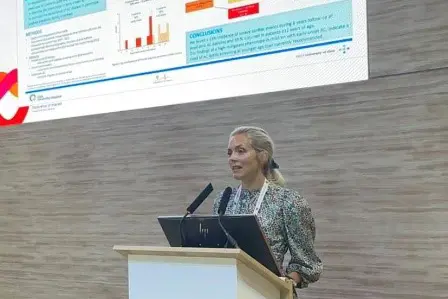Highly malignant disease in childhood-onset arrhythmogenic right ventricular cardiomyopathy
This study aimed to explore the incidence of severe cardiac events in paediatric arrhythmogenic right ventricular cardiomyopathy (ARVC) patients and ARVC penetrance in paediatric relatives. Furthermore, the phenotype in childhood-onset ARVC was described.

Arrhythmogenic right ventricular cardiomyopathy (ARVC) is an inheritable and progressive heart muscle disease characterized by high risk of ventricular tachyarrhythmias and sudden cardiac death, in addition to morphological abnormalities and eventually heart failure. The disease has autosomal dominant inheritance with variants in genes encoding cardiac desmosomal proteins, and it exhibits variable penetrance and expressivity. ARVC diagnosis is made by combining multiple sources of information as described by the consensus-based revised 2010 Task Force Criteria (TFC).
ARVC is considered a disease most relevant to the young adult population, with onset typically observed in the third and fourth decade of life. Penetrance of ARVC disease has been described in adolescents, but is currently considered to be extremely rare under the age of 10. Ten perecent to 25% of sudden deaths in children have been shown to be associated with ARVC. However, children with ARVC are underrepresented in research publications. The clinical characteristics of paediatric ARVC are largely unknown and data is lacking on both the incidence of events in children with ARVC and the penetrance of disease in ARVC genotype positive paediatric relatives.
This study collected three outcomes:
-
Definitive ARVC diagnosis by the revised 2010 TFC4 established ≤18 years of age.
-
Severe cardiac events, defined as cardiac death, heart transplantation (HTx) or severe ventricular arrhythmias. A severe ventricular arrhythmic event was defined as aborted cardiac arrest (ACA), sustained ventricular tachycardia (VT) documented on 12-lead ECG or Holter, or VT or ventricular fibrillation (VF) terminated by appropriate implantable cardioverter defibrillator (ICD)-therapy.
-
Childhood-onset ARVC, defined as meeting definite ARVC criteria at 12 years of age or younger.
Our study showed that 40% of patients with definite ARVC diagnosis had childhood-onset disease. Previous studies, however, have suggested that paediatric ARVC is a disease of adolescents. In the study of Roudijk et al. the youngest relative fulfilling ARVC diagnosis was 11 years old, while one proband was 9 years old. Te Riele et al. reported the youngest patient with a definite ARVC diagnose being 11 years old. According to the 2019 HRS expert consensus document ARVC is considered to be extremely rare under the age of 10 and exclusively seen in probands. A recent review of ARVC in children declared that identifying ARVC prior to age 10 is exceedingly unlikely. Our findings question these statements as we found a high frequency of childhood-onset disease defined as meeting definite ARVC criteria at ≤12 years of age.
This study is to the best of our knowledge, the first to report the incidence of severe cardiac events in ARVC patients ≤18 years of age. Our study demonstrated that ARVC is a highly malignant paediatric disease with a high incidence of ventricular arrhythmias, heart failure and need of HTx. Importantly, 50% of the severe cardiac events occurred in patients ≤12 years of age.
These findings of a high-malignant phenotype in childhood-onset ARVC indicate a need for ARVC family screening at younger age than currently recommended.
Highly malignant disease in childhood-onset arrhythmogenic right ventricular cardiomyopathy | European Heart Journal | Oxford Academic (oup.com)
Eur Heart J. 2022 Dec 1;43(45):4694-4703.
Marit Kristine Smedsrud, Monica Chivulescu, Marianne Inngjerdingen Forså, Isotta Castrini, Eivind Westrum Aabel, Christine Rootwelt-Norberg, Martin Prøven Bogsrud, Thor Edvardsen, Nina Eide Hasselberg, Andreas Früh, Kristina Hermann Haugaa
PMID: 36036653
PMCID: PMC9712025
DOI: 10.1093/eurheartj/ehac485
Shared under Creative Commons (CC-BY-NC) license.
The study was recently commented in an Editorial by pediatric cardiologist Juan Pablo Kaski at Great Ormond Street Hospital, London, UK.
- Arrhythmogenic cardiomyopathies in children: seek and you shall find. Kaski JP.Eur Heart J. 2022 Oct 20:ehac585. doi: 10.1093/eurheartj/ehac585. Online ahead of print.PMID: 36263790
The study was presented by first author, postdoctoral fellow at ProCardio and pediatric cardiologist at the Department of Pediatric Cardiology, Marit Kristine Smedsrud at the ESC Congress in Barcelona in August.
